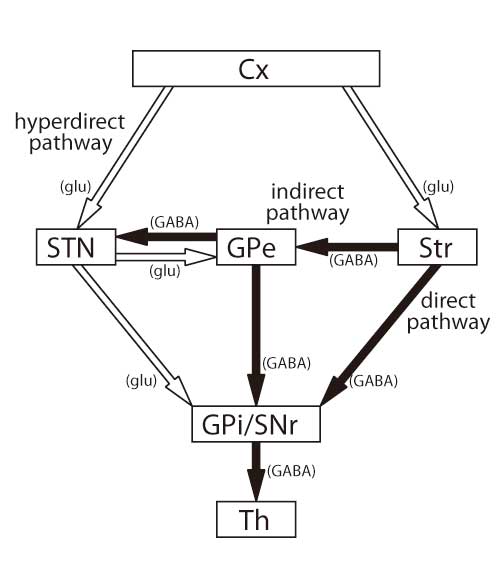Yoshihisa Tachibana, Hitoshi Kita, Satomi Chiken, Masahiko Takada, Atsushi Nambu (2008) Motor cortical control of internal pallidal activity through glutamatergic and GABAergic inputs in awake monkeys. European Journal of Neuroscience (published online on 3 January 2008)
The internal segment of the globus pallidus (GPi) receives motor-related cortical signals mainly through the striatum, the external segment of the globus pallidus (GPe) and the subthalamic nucleus (STN). The GPi sends its outputs outside the basal ganglia and plays a key role in motor control. Extracellular unit recordings were performed in awake monkeys to explore how glutamatergic STN inputs and GABAergic striatal and GPe inputs control spontaneous activity and how these inputs contribute to motor cortex stimulation-induced responses of GPi neurons. The typical responses of GPi neurons to cortical stimulation consisted of an early excitation, an inhibition and a late excitation. Local applications of the NMDA receptor antagonist 3-(2-carboxypiperazin-4-yl)-propyl- 1-phosphonic acid and ⁄ or the AMPA ⁄ kainate receptor antagonist 1,2,3,4-tetrahydro-6-nitro-2,3-dioxo-benzo[f]quinoxaline-7-sulphonamide in the vicinity of recorded GPi neurons reduced the firing rate, and abolished or attenuated both early and late excitations following cortical stimulation. Local application of the GABAA receptor antagonist gabazine increased the firing rate, induced oscillatory firings and diminished the cortically induced inhibition. Muscimol or gabazine injection into the STN or GPe also altered the firing rate, and attenuated the late excitation of GPi neurons. The gabazine injection into the STN occasionally induced dyskinesia with significantly decreased GPi activity. These data suggest that the early and late excitations are glutamatergic and induced by the cortico-STN-GPi and cortico-striato-GPe-STN-GPi pathways, respectively. The inhibition is GABAergic and induced by the corticostriato- GPi pathway. In addition, these inputs are the main factors governing the spontaneous activity of GPi neurons.
